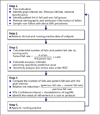Abstract
Purpose
The aims of study were; (1) to evaluate the validity and sensitivity of a fall-risk assessment tool, and (2) to establish continuous quality improvement (CQI) methods to monitor the effective use of the risk assessment tool.
Methods
A retrospective case-control cohort design was used. Analysis was conducted for 90 admissions as cases and 3,716 as controls during the 2006 and 2007 calendar years was conducted. Fallers were identified from the hospital's Accident Reporting System, and non-fallers were selected by randomized selection. Accuracy estimates, sensitivity analysis and logistic regression were used.
Results
At the lower cutoff score of one, sensitivity, specificity, and positive and negative predictive values were 82.2%, 19.3%, 0.03%, and 96.9%, respectively. The area under the ROC was 0.60 implying poor prediction. Logistic regression analysis showed that five out of nine constitutional items; age, history of falls, gait problems, and confusion were significantly associated with falls. Based on these results, we suggested a tailored falls CQI process with specific indexes.
Figures and Tables
Figure 1
ROC curve plotting sensitivity versus 1 specificity for each possible score of the fall risk assessment tool (AROC = 0.6017)

Table 2
Comparison of Items of the Fall Risk Assessment Tool between the Faller and Non Faller Groups

References
1. American Medical Directors Association. Falls and fall risk. 2002. Columbia, MD: American Medical Directors Association.
2. Atman DG. Practical statistics for medical research. 1990. London: Champman & Hall.
4. Brenner H, Gefeller O. Variation of sensitivity, specificity, likelihood ratios and predictive values with disease prevalence. Stat Med. 1997. 16:981–991.

5. Capezuti E, Zwicker D, Mezey M, Fulmer TT, Gray-Miceli D, Kluger M. Evidence-based geriatric nursing protocols for best practice. 2008. 3rd ed. New York: Springer Publishing Company.
6. Chang JT, Morton SC, Rubenstein LZ, Mojica WA, Maglione M, Suttorp MJ, et al. Interventions for the prevention of falls in older adults: systematic review and meta-analysis of randomized controlled trials. BMJ. 2004. 328(7441):680.

7. Gevirtz F, Nash DB. Ransom S, Pinsky W, Tropman J, editors. Enhancing physician performance through practice profiling. Enhancing physician performance: advanced principles of medical management. 2000. Tampa, FL: American College of Physician Executives;91–116.
8. Gray-Miceli D. Capezuti E, Zwicker D, Mezey M, Fulmer TT, Gray-Miceli D, Kluger M, editors. Preventing falls in acute care. Evidence-based geriatric nursing protocols for best practice. 2008. 3rd ed. New York: Springer Publishing Company;161–193.

9. Kim CG, Seo MJ. An analysis of fall incidence rate and its related factors of fall in hospital. J Korean Soc Qual Assur Health Care. 2002. 9(2):210–228.
10. Kim EK, Lee JC, Eom MR. Falls risk factors of inpatients. J Korean Acad Nurs. 2008. 38(5):676–684.

11. Kim KS, Kim JA, Kim MS, Kim YJ, Kim ES, Park KO, et al. Development of performance measures based on the nursing process for prevention and management of pressure ulcers, falls and pain. J Korean Clin Nurs Res. 2009. 15(1):133–147.
12. Laffel G, Blumenthal D. The case for using industrial quality management science in health care organizations. JAMA. 1989. 262(20):2869–2873.

13. Milisen K, Staelens N, Schwendimann R, De Paepe L, Verhaeghe J, Braes T, et al. Fall prediction in inpatients by bedside nurses using the St. Thomas's risk assessment tool in falling elderly inpatients (STRATIFY) instrument: a multicenter Study. J Am Geriatr Soc. 2007. 55(5):725–733.

14. Morse JM, Morse RM. Calculating all rates: methodological concerns. QRB Qual Rev Bull. 1988. 14(12):369–371.
15. Nakai A, Akeda M, Kawabata I. Incidence and risk factors for inpatient falls in an academic acute-care hospital. J Nippon Med Sch. 2006. 73(5):265–270.

16. Oliver D, Daly F, Martin FC, McMurdo MET. Risk factors and risk assessment tools for falls in hospital in-patients: a systematic review. Age Ageing. 2004. 33(2):122–130.

17. O'Connell B, Myers H. Research in brief: the sensitivity and specificity of the morse fall scale in acute care setting. J Clin Nurs. 2002. 11(1):134–135.
18. Park I, Cho I, Kim EM. Comparison of fall rates from different resources: a self report system and an electronic medical record system. Paper presented at the 10th International Congress on Nursing Informatics. 2009. Helsinki, Finland:
19. Perell KL, Nelson A, Goldman R, Luther SL, Prieto-Lewis N, Rubenstein LZ. Fall-risk assessment measures: an analytic review. J Gerontol A Biol Sci Med Sci. 2001. 56(12):761–766.
20. Poses R, Cebul R, Collins M, Fager S. The importance of disease prevalence in transporting clinical prediction rules: the case of streptococcal pharyngitis. Ann Intern Med. 1986. 105(4):586–591.

21. Shortell SM, Bennett CL, Byck GR. Assessing the impact of continuous quality improvement on clinical practice: what is will take to accelerate progress. Milbank Q. 1998. 76(4):593–624.





 PDF
PDF ePub
ePub Citation
Citation Print
Print







 XML Download
XML Download